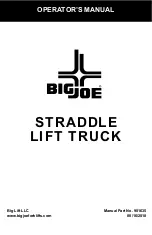
Removal
NOTE
Most repairs to the outer cylinders, such as
repacking the gland nut, can be made without
removing the cylinder from the mast. The
outer cylinders can be removed with the mast
on or off the truck; the procedures are similar.
The mast must be completely extended to
remove the outer cylinders.
1.
Attach a lifting device to the top crossbar of
the middle rail only. Remove the screws and
spacer sleeves at the top of both outer
cylinders (do not allow the rod to spin).
Disconnect the hydraulic tubes from both
cylinders. Remove the roll pin from the
cylinder to be removed.
2.
Use the lifting device to raise the mast near
full extension. Make a note of the shims
between the cylinder rod and the middle rail
crossbar. Lift the cylinder up and out of the
top of the mast.
Replacement
1.
Install the outer cylinder through the top of the
mast. Place the bottom of the cylinder in the
mount and install a spiral roll pin.
NOTE
If a different cylinder is being installed, shims
may need to be added. Refer to Checks and
Adjustments for proper procedures.
2.
Lower the rails and extend the cylinder rod
until they contact. Place the shims noted
during removal between the cylinder rod and
the middle rail crossbar. Install the screws
and spacer sleeves to secure the rods to the
middle rail. Lower the mast completely.
Connect the hydraulic tubes to the cylinder
ports.
3.
Bleed the lift cylinders.
Checks and Adjustments
Check for Leaks
WARNING
DO NOT try to find hydraulic leaks by putting
your hand on hydraulic components under
pressure. Hydraulic oil can be injected into
the body by the pressure.
Operate the hydraulic system. Put a capacity load
on the forks. Use a safety chain to hold the load
to the carriage. Raise and lower the load several
times. Check the lift cylinders and all hydraulic
connections for leaks. Leave the mast elevated
for several minutes to check for drift.
Lift Chain Adjustments
When the lift chains are correctly adjusted:
Ÿ
The tension will be the same on each chain of
the pair. Check tension by pushing on both
chains at the same time.
Ÿ
The chain length will be correct.
Ÿ
The chains must travel freely through the
complete cycle.
1.
Lower the mast completely. Adjust the lift
chains at the top of the outer rail so that the
top of the inner rail is even with the top of the
middle rail within 0.060”
2.
Adjust the free-lift chains at the middle
crossbar of the inner rail so that the heel of
the forks are 1/4” to 3/8” off the floor when the
mast is vertical (bottom of the carriage will be
3” - 3½“ off the ground).
3.
When the chain adjustments are complete,
tighten the second nut on each chain anchor
and make sure the cotter pin is in place.
4.
Check the clearance of the carriage when
center cylinder is at full extension. The
carriage stop blocks must not touch the stop
bolts at the top of the inner rail.
Load Rollers
During assembly, the shim arrangement will be
approximately the same as before disassembly.
Check the clearance and adjust for wear or
changes because of repairs.
The load rollers control the alignment of the rails.
The alignment conditions are listed below in order
of importance:
a) The rails must be parallel to each other.
b) Use shims to adjust the load rollers so that
there is 0.001 to 0.010 in. clearance between
the load roller and the channel at the point of
tightest fit.
c)
The number and thickness of shims under a
load roller must be approximately the same as
E
lectric
C
ounterbalance
H
igh
O
utput
Elevating
3/10/00
7.10


































